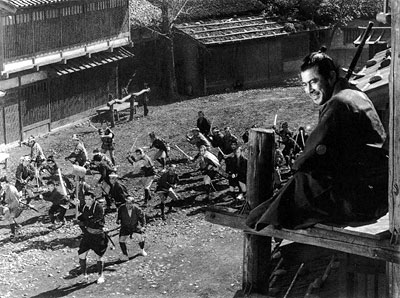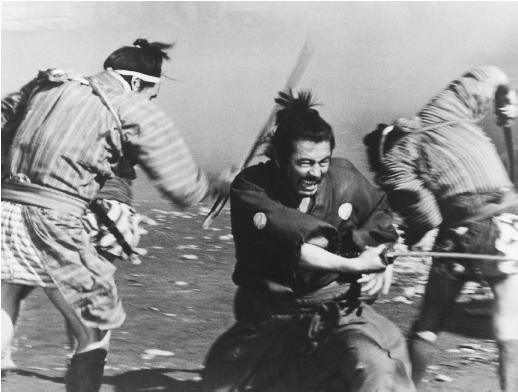A small precursor: I am taking a class in Japanese Cinema, and will be writing thoughts about some of the films here as the class progresses.
I also apologize for the lack of updates, but as summer ends and school begins, what can you do?
The character played by Toshiro Mifune, is firstly known as Sanjuro Kuwabatake, but that name seems to be a play on the fields that Sanjuro stares at the moment he says in name, as well as his age. A precursor to the Man With No Name from Sergio Leone’s A Fistful of Dollars (1963), Sanjuro enters the town with no objective, but only as a curious observer. When he learns of the two warring clans, he decides to exploit and kill both. For Stephen Prince in his book The Warrior’s Camera, Sanjuro “has no ethical reason for doing so, no ideal to which he commits” (223).
However, Sanjuro is surely fighting for the side of good, even if he is ever so hesitant to reveal such an ideal. The samurai never attacks anyone on purpose, his main fights are when he is being attacked by others and thus defends himself. In fact, he only intervenes in the action twice in the film—to save the kidnapped woman from the men (which someone suggests would take the power of sixteen men), and during the final battle, when is main objective really is saving Gon, though he does slaughter the remaining bodyguards in the process. Also of note is that Sanjuro kills neither of the lords that are in the feud, only the men who protect them.
Sanjuro carries some angelic qualities, and Kurosawa often portrays him as if from another world. Not only does he have no name or past, but also he is emotionally removed. For most of the film, he is reserved and joking, and “amused” by the war between the villagers. The performance by Mifune is also atypical of him, reserving his emotions only for the bloody battle sequences, as compared to his larger-than-life emotions in films like Seven Samurai (1954) and Throne of Blood (1957). Additionally, in one of the film’s most iconic shots, Kurosawa uses a low-angle shot of Sanjuro sitting high atop a perched outlook as the two sides attempt to fight, not only making him emotionally and philosophically above the fight, but literally as well. This is not without mentioning his overall strength compared to every one of the bodyguards in the film, none of which put up much of the fight, except for the nameless gunfighter, who is in many ways also a deity of sorts, not only by his anachronistic weapon, but his entrance in tumultuous weather in which the constable notes how, “even the wind welcomes you.”
Kurosawa uses the camera in more pointed ways to suggest Sanjuro’s angelic qualities, most notably a gag in which Sanjuro hides in a coffin, suggesting he has already died, and Gon even tells him he looks like he is dead after he has been kidnapped. Donald Richie in The Films of Akira Kurosawa also notes his ability to control the film itself, using the non-diegetic sound. He writes, “When Mifune initially calls on one of the bad leaders he climbs the stairs, slowly. After each step, in the silence between each footfall, there is music. It is like secco reccitaif for the dance” (153). Prince also mentions Sanjuro’s actions directly controlling the narrative of the film, calling him “a kind of surrogate director” (224). In the film’s final shot, Kurosawa continues this suggestion, as Sanjuro literally fades, and as Prince describes it, “Like a shadow flitting across a wall” (231).
So why make a film about an angelic figure intervening and destroying the lives of humans? One interpretation is to read the film as Sanjuro’s sick joke on Gon, who finally gets the town to be “quiet” in the end. The film certainly fits in with Kurosawa’s other films that deal with ambiguous moral grounds, such as High and Low (1962) and Stray Dog (1949). Kurosawa does not see Sanjuro’s actions as the morally right solution, though he does not propose any other solutions. The town may be quiet, but the path of destruction left only leaves Gon and the few people left to a life of even greater devastation. One could read Sanjuro in a political and historical allegory of the United States “cleaning” Japan, as the images of the destructed town seem to recall photographs of the firebombed villages, but such a reading is too easy and too simplistic for Kurosawa’s intelligence. Instead, Kurosawa has offered up the ultimate morality play about the control of power, and who is allowed to fight battles for others. The ultimate joke seems to be played on Gon. He wants his village to be quiet, a promised that is fulfilled, but the consequences devastating.
Two Texts were referenced in the above article:



No comments:
Post a Comment